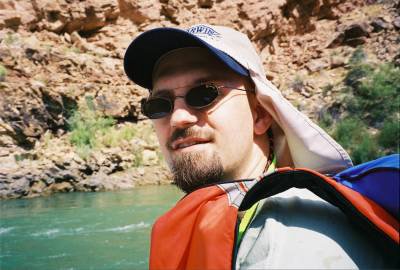
My, how hard creationists work to make sure that visitors to the Grand Canyon believe that Noah's flood could have done it. In a book written by Steven Austin (not the "Stone Cold" WWE wrestler) titled "Grand Canyon: A Different View," the idea is profferred that a massive flood event could have both laid down the sediments and then rapidly carved them afterwards due to a damming event. In short, it took a lot of water over a little time, as opposed to a little water over a lot of time.
Now, I've known for some time about the holes in this idea. Desert footprints in the Coconino sandstones, for example. Or travertine deposits in the Tapeats sandstone from an extinct and buried riverbed which had been carving its own canyon prior to being buried by new sediments from an advancing sea. But I've just come back from a fantastic road trip with my dad, and it seems that the holes in the creationist idea are even more gaping than I'd originally thought.
You see, the Grand Canyon is only part of the story. The layers which comprise the Grand Canyon are part of the overall Colorado Plateau, and these layers correlate to each other, making any creationist attempt to explain the Grand Canyon being carved by a breached dam from a now-extinct lake being left over from Noah's deluge a half-assed attempt, at best. It's like blaming one kid for all the graffiti in Chicago -- it's just too simple an explanation to be true.
Here's what I saw on my trip: The uppermost layers of the Grand Canyon, the Kaibab limestone, make up the lowermost layers of Zion National Park in Utah, whose towering canyon peaks are a sight to behold! Furthermore, the uppermost sandstone layers of Zion national park's mountain-peaks comprise the lowermost layers of Bryce Canyon National Park, also in Utah. These three make up what's known as the Grand Staircase (even though an area in the center of these three has been recently dubbed Grand Staircase-Escalante National Monument). That means that any "breached dam" creationists propose has to not only carve out the Grand Canyon, but also carve out Zion canyon, and somehow erode Bryce Canyon in a way which leaves hundreds and hundreds of hudoos (a hudoo being a towering chimney composed of eroding sedimentary layers, with larger tops than bottoms). Any rushing water would topple any column structures of Bryce Canyon, even if it were part of the creationists' bogus breached dam area, which it isn't, and even if Zion canyon weren't too far to the West to get carved out by said dam, which it is.
And there's more. Precambrian schist which is contemporaneous with the Vishnu shist at the bottom of Grand Canyon can be seen in Durango, Colorado, located on the Durango-Silverton rail line. Clearly visible from the tourist train is the layers of shist, and a v-shaped area where a river once carved out a channel before the whole area became embedded with sediment once again. Now, this layer would long predate any flooding event proposed by a Noachian hypothesis, so it again makes for a proper headache for biblical literalists. And these layers are also contemporaneous with the Black Canyon of the Gunnison, whose half-mile high cliff walls are composed entirely of pre-Cambrian schists. There's simply no way this ultra-hard canyon rock could have been laid down by Noah's flood, just as it is equally impossible that such ultra-hard rock could have eroded such a massive canyon in less than 6,000 years.
So the next time some creationist tries to spin-doctor Grand Canyon, ask him, what about Zion? What about Bryce Canyon? And what about the Black Canyon of the Gunnison? How do those fit Noah's flood?
Chances are, he'll not know. Not only because he hasn't confronted the question before, but because these geologic features don't fit his absurd world-view at all.
Eric.



No comments:
Post a Comment